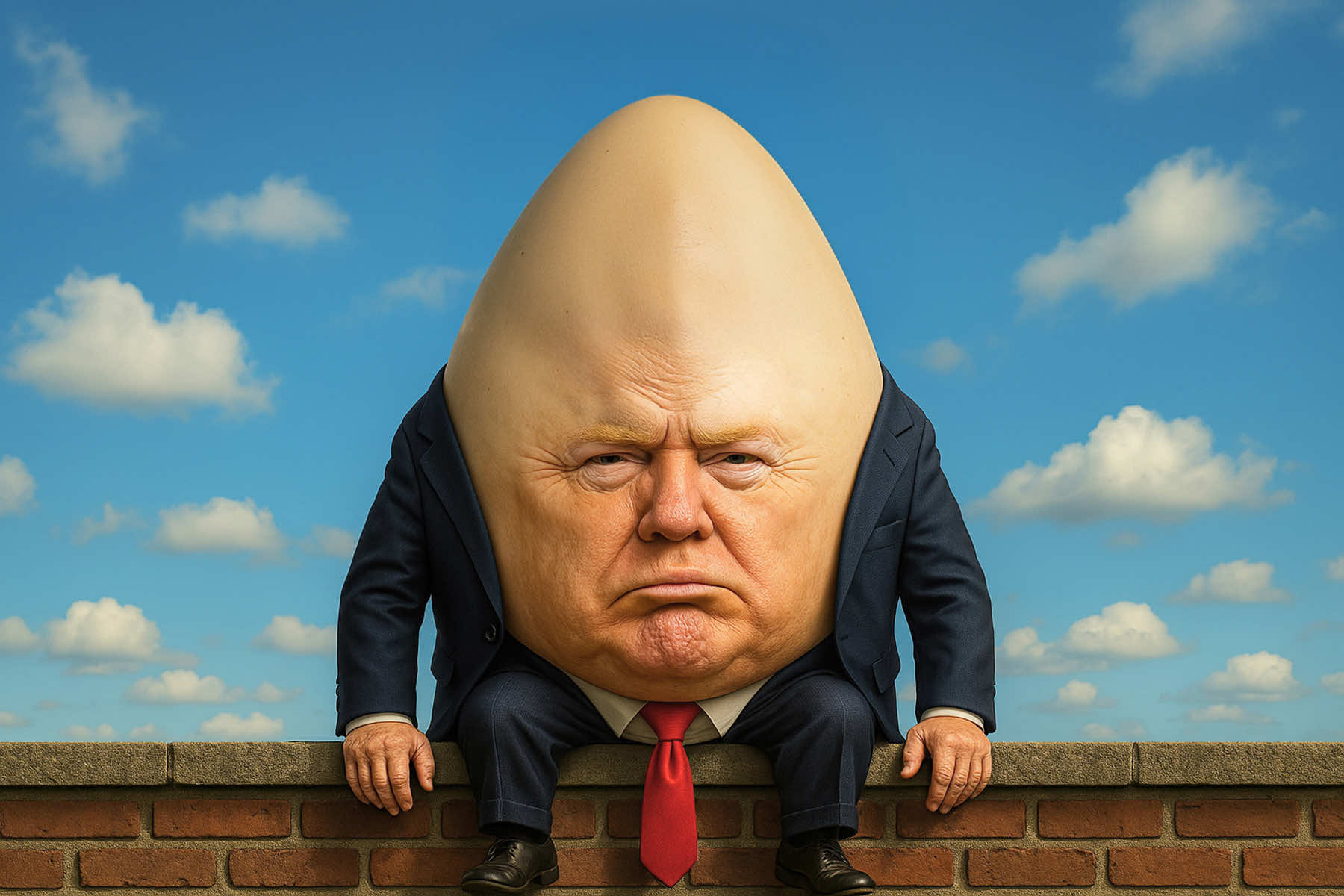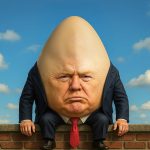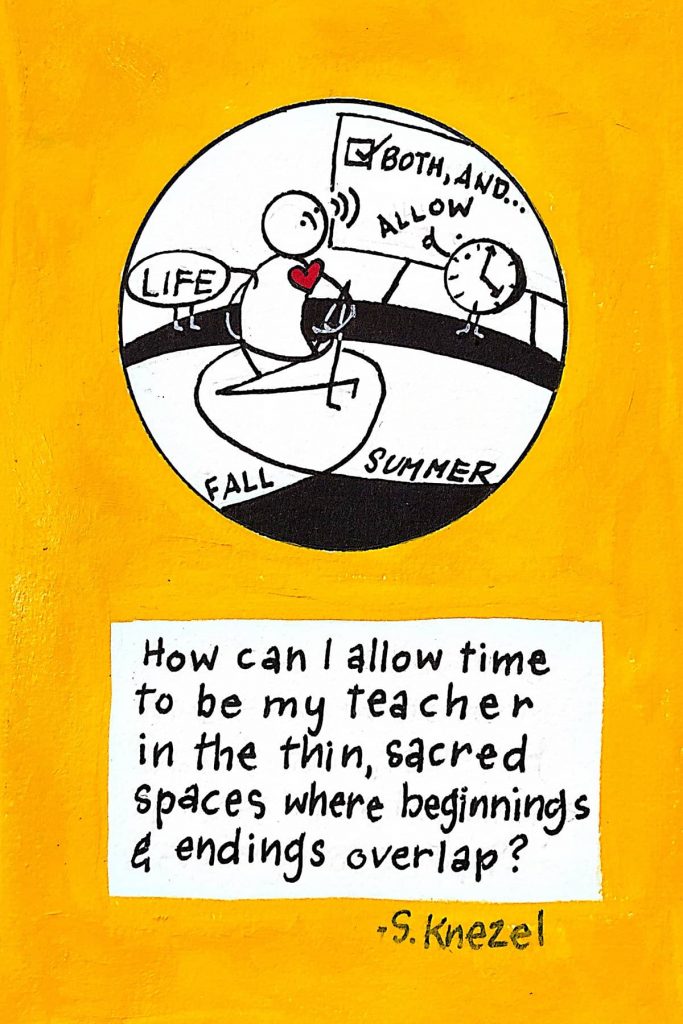
This AI-generated image is a photorealistic editorial illustration and not an actual photograph. It was created to support a journalistic commentary as a political cartoon.
The office of the presidency is not a birthright. It is not a crown. It is not held by force, and it is not above the law. It exists entirely within the framework of the U.S. Constitution, granted by a document whose legitimacy rests on the rule of law and the consent of the governed.
As such, when a president moves to dismantle the very structure that defines the authority of that office, he forfeits the claim to lawful power.
Donald Trump has escalated his public and private efforts to consolidate personal control over the federal government while openly disregarding key constitutional principles. These include attempts to subordinate the Department of Justice, circumvent judicial independence, neutralize oversight by Congress, and threaten retribution against political opponents.
Critics argue that these actions amount to a slow erosion of the system of checks and balances that define the American republic.
The foundational problem lies not merely in rhetoric, but in operational reality. When constitutional rules are discarded by the executive, the legal authority that underpins the office is voided.
A president who claims power outside the legal limits of the Constitution no longer occupies a constitutional office, but rather holds control through extralegal means.
Legal scholars and watchdog groups have raised increasing concern over recent executive efforts to alter or ignore statutory limitations on presidential conduct. These include moves to bypass congressional appropriations, refusal to comply with lawful court orders, and leveraging federal law enforcement for political ends.
At the core of these concerns is a growing sense that the executive branch, under Trump’s leadership, is actively disengaging from constitutional norms while still demanding the legitimacy they confer.
The Constitution cannot be selectively obeyed. It provides the president with the authority to command the armed forces, sign legislation, and oversee the federal bureaucracy, but also imposes binding limits on that power. If the limits are no longer recognized, then neither is the authority.
A president cannot simultaneously destroy the foundation of the law and claim the protections it affords.
This conflict has become more than theoretical. The Department of Justice, now reshaped by loyalty appointments, has reversed its own investigations into alleged criminal behavior by the Trump and his inner circle. In parallel, a coordinated purge of senior FBI officials and career prosecutors has signaled a dramatic departure from institutional independence.
Executive orders have expanded internal surveillance powers, revoked oversight protocols, and threatened whistleblowers with retaliation.
At the same time, the White House has continued to reject the legitimacy of judicial decisions it disagrees with, attacking courts that issue adverse rulings and refusing to implement certain decisions. These actions have been defended by administration officials as necessary measures against what they describe as an entrenched political enemy.
Historically, constitutional democracies do not end in a single coup. They unravel when institutions begin yielding to political loyalty over legal authority. The executive branch’s consolidation of power — when coupled with congressional inaction and judicial hesitation — creates a vacuum where the presidency becomes unbound by law, even as it continues to demand recognition under it.
This creates a dangerous paradox. If the Constitution is no longer enforceable upon the president, then by what standard does the office retain its legitimacy?
Presidential power does not exist outside the Constitution; it is not a natural law or divine right. It is a legal designation with conditions. Break those conditions, and the office is no longer being exercised — it is being impersonated.
In practical terms, the United States may now face a scenario in which constitutional government exists only in form. If the president declares himself immune from investigation, oversight, or judicial review, and no institutional body responds with enforcement, the result is not just lawlessness — it is regime change under the appearance of continuity.
Public frustration has grown as legislative responses stall. The House of Representatives has declined to initiate further impeachment proceedings, citing political constraints and a lack of bipartisan will. The Senate, controlled by a majority aligned with the administration, has blocked efforts to investigate or limit the president’s expanding powers. Meanwhile, the Supreme Court has avoided issuing rulings on several emergency petitions related to executive overreach, citing procedural grounds.
The Constitution provides remedies — including impeachment, judicial review, and electoral consequences — but each depends on the active participation of other branches. When those branches are neutralized or unwilling, the presidency drifts beyond the reach of law.
The result is a presidency that has effectively separated itself from constitutional accountability while still insisting on the privileges that structure provides. By rejecting the legitimacy of limits, the office becomes a personal instrument of power — not a public trust.
This inversion of authority leaves the public without clear legal recourse, as every traditional safeguard depends on institutional enforcement that no longer functions independently.
The deeper consequence is psychological as much as legal. When the public observes that laws no longer apply equally — that some figures can ignore subpoenas, evade prosecution, or rewrite policy without due process — the social contract begins to fracture.
Trust in democratic governance is not sustained by ceremony or tradition. It depends on the belief that power is bound by rules and subject to consequences. When that belief collapses, legitimacy becomes a matter of perception, not law.
That perception has already shifted among large segments of the American population. In the absence of enforcement, many citizens now interpret constitutional violations not as disqualifying acts, but as evidence of strength or resolve.
The use of executive power for personal protection, political retribution, or institutional dominance is defended as necessary warfare in a polarized climate. This shift redefines authoritarian conduct as patriotism and casts legal accountability as sabotage.
Institutional resistance has not disappeared entirely. Isolated voices within the judiciary, legal community, and civil service have attempted to raise alarms, file objections, or resign in protest. But the effect of such acts has been largely symbolic in the face of coordinated structural power.
Some state governments have moved to assert their own constitutional independence, introducing legislation to limit cooperation with federal mandates deemed unlawful or abusive. However, their capacity to enforce such measures is constrained by the supremacy of federal law — a principle that presumes the federal government is operating within constitutional bounds. If that presumption no longer holds, the entire federalist structure is destabilized.
The media landscape has also been affected by the executive’s disregard for constitutional norms. Press access has been curtailed. Government communication is tightly controlled. Legal threats and retaliatory actions against journalists have become more frequent, contributing to an environment where public scrutiny is diminished and misinformation flourishes.
Despite the gravity of these developments, a large portion of the population continues to view the presidency through a lens of normalcy. Familiar rituals — the State of the Union, press conferences, campaign rallies — continue uninterrupted. But beneath these surface displays, the functional relationship between the branches of government has ruptured.
The danger is not that Trump openly declares himself above the Constitution. The danger is that he continues to act as though he is — and no institution stops him. The presidency becomes not a role within a system, but the system itself. And in that environment, opposition is not treated as a lawful check, but as a threat to authority.
Ultimately, the Constitution is not self-enforcing. It depends entirely on people — in Congress, in the courts, in the public — who are willing to defend it, not merely reference it. When those people retreat or rationalize inaction, the document becomes inert. It can still be read, quoted, and celebrated, but it no longer binds power.
If that point has already been reached, then the question is no longer whether the president is violating the Constitution. It is whether the presidency, as defined by the Constitution, still exists. If the legal boundaries have been erased, then what remains is not an office under law, but a position held by force, myth, and machinery.
In such a state, compliance is not governed by consent — it is demanded through dominance. And when that is the basis for power, Americans are not subjects of a constitutional republic. They are subjects of the man who seized it, and live under a dictatorship.
This AI-generated image is a photorealistic editorial illustration. It is not an actual photograph and does not depict a real situation. The image was created to support commentary protected under the First Amendment of the U.S. Constitution as a form of political expression. Its use is consistent with established legal precedent, including the Supreme Court’s decision in Hustler Magazine, Inc. v. Falwell, 485 U.S. 46 (1988), which affirmed that satire and parody involving public figures are protected forms of speech and are not considered defamation unless containing knowingly false factual assertions made with actual malice.
ChatGPT-4o













